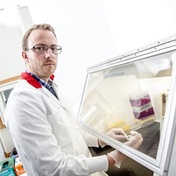Using skin cells from a child with spinal muscular atrophy, researchers grew batches of nerve cells with the same genetic defects. The finding allowed scientists to watch the nerve cells die off.
Replaying the disease process"Now we can start from the beginning of development and replay the disease process in the lab dish," Clive Svendsen of the University of Wisconsin-Madison said in a telephone interview.
The finding, reported in the journal Nature, marks the latest advance in research that reprogrammes ordinary cells to look and act like embryonic stem cells - the master cells of the body that can produce any type of tissue or blood cell.
Spinal muscular atrophy is the most common cause of childhood death caused by a genetic mutation, Svendsen said. It is caused by a deficiency of a protein called SMN, for survival of motor neurons.
"That SMN protein is important for motor neuron survival. They are the cells that make muscles move," Svendsen said.
Infants with the most severe form of the disease develop normally for the first six months of life, and then gradually develop muscle weakness and loss of motor control.
"They end up completely paralysed," Svendsen said, adding they typically die around age 2.
Making neurons
Svendsen's team made motor neurons that contained the genetic defect that causes SMA with a powerful new type of cell called induced pluripotent stem cells, or iPS cells, which behave like embryonic stem cells.
The researchers used skin cells from a child with SMA to make iPS cells, and induced these cells to become motor neurons. Because every cell in the body contains the same genetic instructions, the motor neurons made from the child also carry the genetic disease.
The team also made motor neurons with cells from the child's healthy mother.
After two months, the motor neurons from the child's cells began to die, while the mother's neurons kept developing normally.
"We suddenly had a split and it was related to the lack of the SMN protein," Svendsen said.
Since iPS cells can grow for months or years in the lab, the experiment can be repeated in many batches of cells.
Svendsen likens it to a video of a car accident.
"You can watch the tape again and again and work out how the accident happened. In iPS, it allows you to replay the disease," he said.
Allows drug testing
Svendsen said the discovery will allow drug makers to test potential treatments to prevent nerve death in SMA.
His lab is one of many using iPS cells as a new tool for studying disease.
Earlier this year, Harvard Stem Cell Institute's Kevin Eggan created iPS cell lines from skin cells of patients with amyotrophic lateral sclerosis, or ALS, commonly known as Lou Gehrig's disease.
(Reuters Health, December 2008)
Read more:
Genetics Centre




 Publications
Publications
 Partners
Partners










